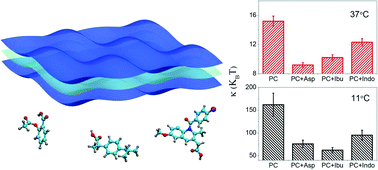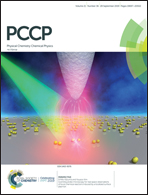Membrane softening by nonsteroidal anti-inflammatory drugs investigated by neutron spin echo
Abstract
In spite of their well-known side effects, the nonsteroidal anti-inflammatory drugs (NSAIDs) are one of the most commonly prescribed medications for their antipyretic and anti-inflammatory actions. Interaction of NSAIDs with the plasma membrane plays a vital role in their therapeutic actions and defines many of their side effects. In the present study, we investigate the effects of three NSAIDs, aspirin, ibuprofen, and indomethacin, on the structure and dynamics of a model plasma membrane using a combination of small angle neutron scattering (SANS) and neutron spin echo (NSE) techniques. The SANS and NSE measurements were carried out on a 1,2-dimyristoyl-sn-glycero-3-phosphocholine (DMPC) membrane, with and without NSAIDs, at two different temperatures, 11 °C and 37 °C, where the DMPC membrane is in the gel and fluid phase, respectively. SANS data analysis shows that incorporation of NSAIDs leads to bilayer thinning of the membrane in both the phases. The dynamic properties of the membrane are represented by the intermediate scattering functions for NSE data, which are successfully described by the Zilman and Granek model. NSE data analysis shows that in both gel and fluid phases, addition of NSAIDs results in a decrease in the bending rigidity and compressibility modulus of the membrane, which is more prominent when the membrane is in the gel phase. The magnitude of the effect of NSAIDs on the bending rigidity and compressibility modulus of the membrane in the gel phase follows an order of ibuprofen > aspirin > indomethacin, whereas in the fluid phase, it is in the order of aspirin > ibuprofen > indomethacin. We find that the interaction between NSAIDs and phospholipid membranes is strongly dependent on the chemical structure of the drugs and physical state of the membrane. Mechanical properties of the membrane can be quantified by the membrane's bending rigidity. Hence, the present study reveals that incorporation of NSAIDs modulates the mechanical properties of the membrane, which may affect several physiological processes, particularly those linked to the membrane curvature.

- This article is part of the themed collection: PCCP Editor’s Choice, 2020


 Please wait while we load your content...
Please wait while we load your content...
